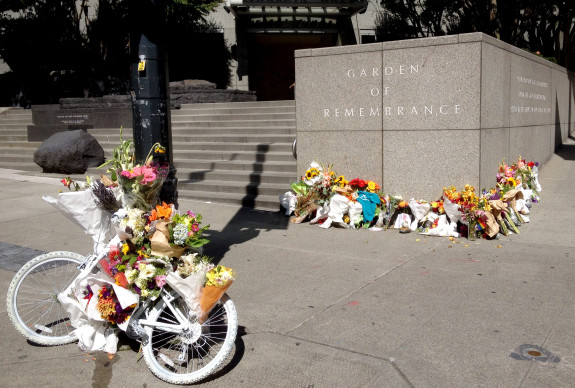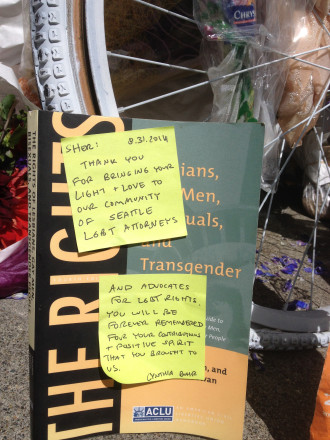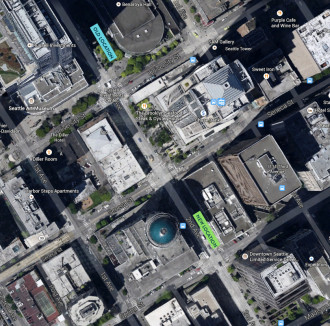
 As news spread that a young and popular lawyer had died biking to work downtown, mourners came to 2nd and University to pay their respects. Many left flowers, some left notes. Two people brought ghost bikes. One person even left a copy of a book about fighting for LGBT rights, a cause Kung was dedicated to furthering.
As news spread that a young and popular lawyer had died biking to work downtown, mourners came to 2nd and University to pay their respects. Many left flowers, some left notes. Two people brought ghost bikes. One person even left a copy of a book about fighting for LGBT rights, a cause Kung was dedicated to furthering.
She was on the legal team that won a case that became instrumental in the repeal of the Don’t Ask, Don’t Tell military policy barring openly gay service members. This made the site of the spontaneous memorial to her even more powerful, since it is also home to the Garden of Remembrance honoring military veterans.
Now, the city is getting ready to remove one of the two ghost bikes left in Kung’s honor, but they want everyone to know why. SDOT Community Engagement Liaison Dawn Schellenberg reached out to Seattle Bike Blog to explain that, being on the busy corner, it interferes with heavy walking traffic. The second ghost bike is further from the corner and will remain there.
From SDOT:
To help with pedestrian movement, the Seattle Department of Transportation is preparing to remove one of the two ghost bikes commemorating Sher Kung’s memory. The one being removed is closest to the intersection and curb ramp. The reason we’d like to remove it is to help with pedestrian congestion/movement in the area. The department will follow typical procedures and tag the bike with a 72 hour removal notice prior. Currently there are no plans to remove the second ghost bike.
 This news comes just after Pronto Cycle Share moved the 2nd and University station (named the “Sher Kung Memorial Station”) a couple blocks down the hill due to concerns that it was “imping[ing] on the peaceful and contemplative nature of the memorial.”
This news comes just after Pronto Cycle Share moved the 2nd and University station (named the “Sher Kung Memorial Station”) a couple blocks down the hill due to concerns that it was “imping[ing] on the peaceful and contemplative nature of the memorial.”
The station was popular due to its location near University Street Station and 2nd Ave.








Comments
22 responses to “City will remove one of the Sher Kung ghost bikes”
This is a waste of taxpayer resources. The ghost bike being removed does nothing to interfere pedestrian movement in any way, and there is no “congestion” as suggested at this corner. Sad move, who instigated this?
I can understand the pedestrian issue, the bike projects into the clear space around the wheelchair ramp. But could something else be put in its place?
Spontaneous roadside memorials led to the creation, years ago, of official memorial signs for those who died in DUI crashes. Perhaps it’s time for an official “ghost bike” design, something conspicuous yet small enough not to interfere with pedestrians…
A metal sign, just like a standard traffic sign, with a bicycle wheel as a frame around the image of the deceased, the date of the accident, and an inscription recognizing community revulsion at senseless traffic deaths?
If it’s blocking the ramp, it should be adjusted. If the bike is being moved to simply provide more square feet for people waiting at the light, however, it seems the city is missing the point. Ghost bikes are an honor to the people killed on a bike but they’re also a reminder to us all to be cautious around each other when driving and riding. These kinds of messages should be as visible as possible. We should be reminded every day that someone paid a price for riding a bike rather than driving a car and reflect on how screwed up that is.
The fact that the city allows these impromptu memorials is refreshing and deserves acknowledgement. I’ve been a little confused by the fact that there are two in that location rather than one – I don’t mourn the loss of one of them.
In Madison WI there was a recent kerfluffle when a resident complained about a ghost bike (commemorating the loss of Brendan Pimm) in a much less congested location and the city found that there was no legal basis for them to leave it in place, a situation that city officials are thankfully working to correct. Here’s the story:
http://host.madison.com/ct/news/local/govt-and-politics/madison-alders-consider-allowance-for-ghost-bikes/article_5e18276e-3dad-5731-a094-7775ddd1d753.html
What is messed up is that a man cycling southbound in the cycle track was struck yesterday evening by a motorist illegally turning left across it, in just the same manner as the driver who killed Sher Kung. Drivers are still ignoring the ridiculously obvious lights and signage, and every time one of them does I think of Ms. Kung and all of the other people who have been killed by motorists on this street. It’s like a slap in the face every time I see someone do that.
Yep, this happened right after I rode by, I was heading uphill so he waited for me and a couple others to clear the intersection, then turned even though the light was clearly still red. The rider heading downhill had no chance to stop. Sad that we can spend money and resources to try to make things safer, but in the end drivers just don’t abide by the rules anyway. I hope he was cited for running a red light, I wouldn’t count on it though.
It should come as no shock that motorists routinely ignore warning and prohibition signs. They do it all the time on the cycle track on Broadway. Lots of cars make right turns on red from E Pine and E Pike to Broadway. Unless these illegal turns are enforced there’s no reason why anyone would obey these signs. Many motorists assume that right turn on red means that you can always make a right turn on red even if it’s not safe to do so. If a police person catches someone doing it it’s a $198 ticket, but it’s unlikely that many people (if any) are ever ticketed.
The signs seem obvious if you know they’re there, but honestly, those clustered signals and tiny signs are confusing to many drivers. Maybe they shouldn’t be, but they are.
In addition to throwing the book at violators, I believe SDOT should take a deeper dive on human factors and improve the user interface:
* Physically separate the bike path signals from the street signals – put the signal heads over the lanes they control.
* Use the largest approved size of the “NO TURN ON RED” signs and the “BICYCLE SIGNAL” signs — through a windshield on a rainy day, the existing signs really aren’t all that conspicuous.
* Consider a supplemental “NO TURN ON RED” on the near side of the intersection, where it’s clearly visible while a driver is looking for conflicting traffic before making a turn. The signals on 2nd are high enough up that you can’t see them when you’re scanning for traffic, and some people genuinely don’t remember the “NO TURN ON RED” once they’re looking at ground level again. (The law says they should, but reality says they don’t.)
Excellent observations and suggestions – can SDOT get these? Have you forwarded them on? Thanks!
Whatever happened to the driver that killed Sher Kung? Did he just mention that he didn’t see her because she was in his “blind spot” and become absolved of this killing?
Can it be preserved elsewhere, maybe at MOHAI? All of us need to be reminded how inattentive operation of a vehicle (whether it’s a car, truck, or bike) can end in tragedy; and SDOT and SPD need to be reminded that awful street design and lack of enforcement can also end in tragedy.
Perhaps it’s time to consider the elimination of right on red, like NYC, most of Canada, and nearly all of Europe?
One of the issues with the 2nd Ave bikeway is that it is on the east side of a one way street so the issue is with drivers turning left off of 2nd across the bikeway.
Street design together with speed limits are the two things that can make the biggest difference when it comes to the reduction/elimination of driving related fatalities. Look at Sweden and the Vision Zero approach if you want to see meaningful change around this issue.
http://daily.sightline.org/2015/02/03/what-is-vision-zero/
The problem on 2nd is left on red, but yes, right-on-red is a serious pedestrian risk in urban settings in addition to increasing the risk of right-hook collisions for people on bikes.
But even if Seattle banned right-on-red tomorrow, we have 40 years of drivers trained that right-on-red is nearly always allowed, you’d still need years of enforcement and re-education to retrain local drivers, and Seattle has a continuous influx of drivers from the rest of the U.S., so the problem wouldn’t go away any time soon. (Not that that’s any reason to delay starting the solution, just don’t expect a quick fix.)
The argument has been that the ability to do “right on red” supposedly saves fuel since people aren’t idling. But more often than not it’s an excuse for people to do right on red *regardless* of whether it’s safe to do so.
The truth is that lots of drivers are just inattentive.
While riding home in the 2nd Ave. bike path a few nights ago, I saw a car one block ahead of me pull a U-turn on 2nd into the bike lane and drive the wrong way back up 2nd completely within the bike path. Kind of interesting to all of a sudden have a BMW taking up the whole path driving straight towards you.
Maybe tighter bollard spacing and a concrete curb would be helpful to make it impossible for cars to get into the bike path without some damage to their vehicle.
Maybe if the delineator posts on the path were properly marked?
MUTCD would say any obstruction in the path should have yellow hazard warning stripes leading up to them and in a diamond around them. (See http://mutcd.fhwa.dot.gov/htm/2003r1r2/part9/fig9c-02_longdesc.htm for description and image of what the striping around the centerline posts should look like.)
While that’s intended to help path users avoid hitting them, it would also make it much more obvious that you’re not driving in a normal travel lane, even when the posts have been knocked down.
When I rode by yesterday there were removal notices on both ghost bikes… :(
Meg is correct, there is a notice on both bikes.
I called Stanley Ho, Field Investigator for SDOT, and he stated that it was his understanding that BOTH bikes would be removed. I asked about the SDOT notice saying that only one would be removed and he said he didn’t know about that, and that he would have to contact his supervisor Monday and get back to me.
I’ll make another comment when I hear more.
Thanks for your work tracking this down! I think it’s totally reasonable for there to be only one there, but I sure hope the city does not remove them both.
I spoke with Stanley Ho at SDOT again Monday morning. After he spoke with supervisors he said that one bike would stay, and confirmed that the bike near the wheelchair ramp would be the one to be removed. Good news!
Tom, did SDOT comment on what happens to the bike after they remove it? Are they giving it to the family? Perhaps MOHAI might add it to their collections?